Organizational Behaviour Report: Personality, Management Style, Errors
VerifiedAdded on 2022/08/20
|12
|2851
|14
Report
AI Summary
This report delves into the realm of organizational behavior, focusing on the application of the Big Five personality assessment. The student analyzes their own Big Five results, discussing the positive and negative aspects of each dimension (openness, conscientiousness, extraversion, agreeableness, and neuroticism) and how these traits might influence their work performance. The report then transitions into a managerial context, proposing a suitable management style (Consultative) based on the personality assessment and supporting this choice with relevant research. Finally, the report examines the impact of perceptual errors, such as projection and the similar-to-me effect, within an organizational setting, highlighting potential biases and their consequences on team dynamics and performance evaluations. The analysis provides a comprehensive understanding of how personality influences work-related behaviors and managerial effectiveness.
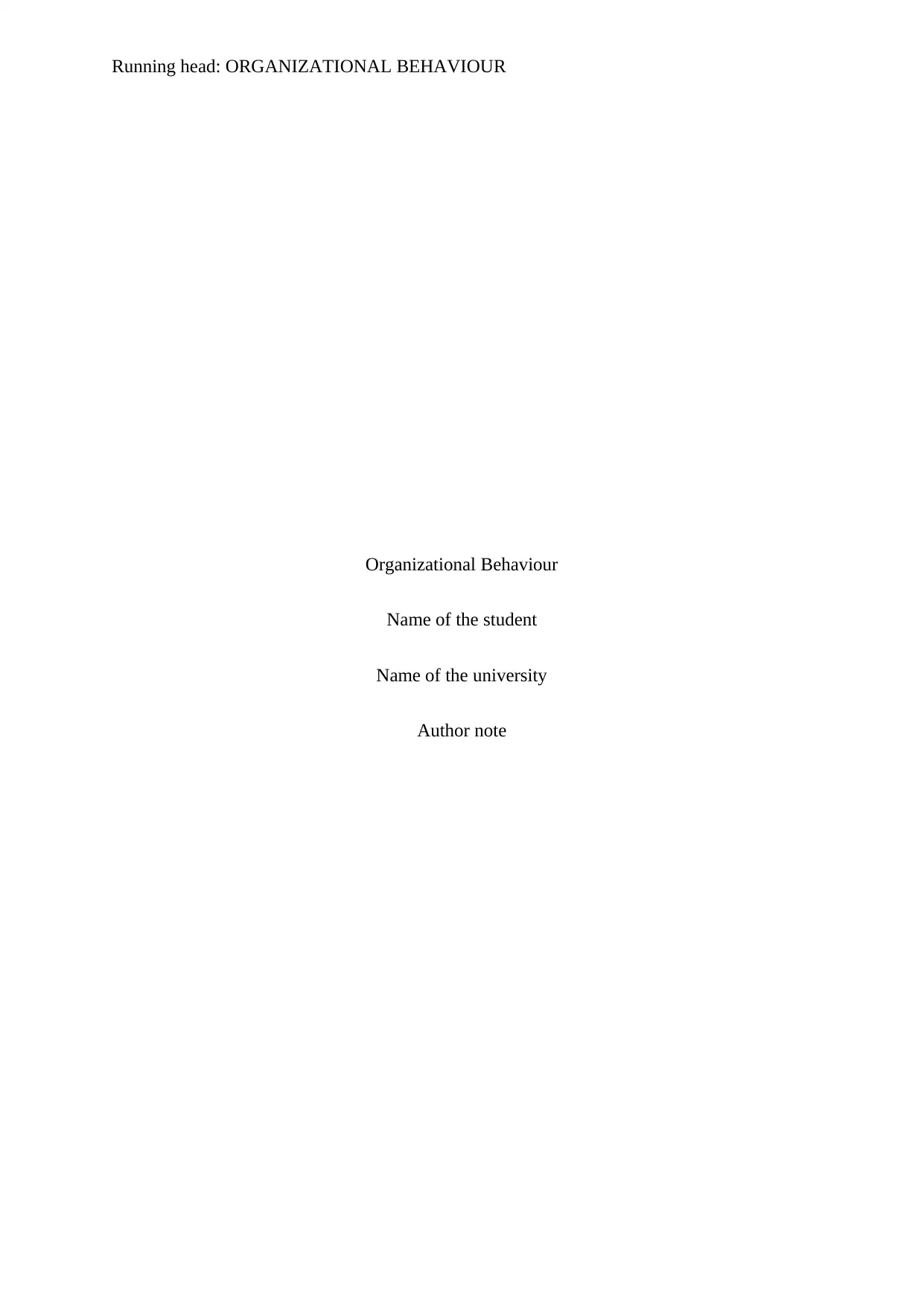
Running head: ORGANIZATIONAL BEHAVIOUR
Organizational Behaviour
Name of the student
Name of the university
Author note
Organizational Behaviour
Name of the student
Name of the university
Author note
Paraphrase This Document
Need a fresh take? Get an instant paraphrase of this document with our AI Paraphraser
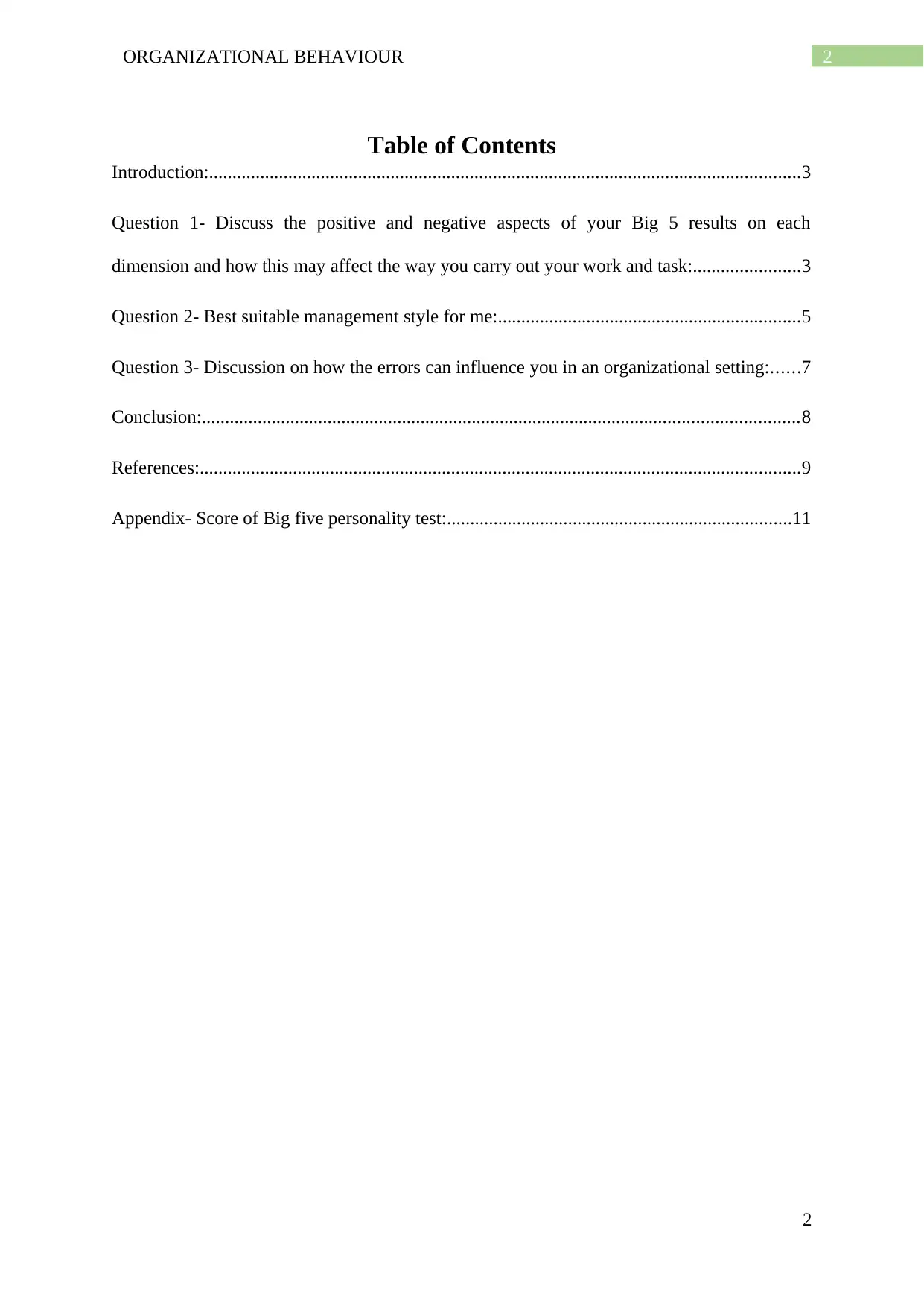
2ORGANIZATIONAL BEHAVIOUR
Table of Contents
Introduction:...............................................................................................................................3
Question 1- Discuss the positive and negative aspects of your Big 5 results on each
dimension and how this may affect the way you carry out your work and task:.......................3
Question 2- Best suitable management style for me:.................................................................5
Question 3- Discussion on how the errors can influence you in an organizational setting:......7
Conclusion:................................................................................................................................8
References:.................................................................................................................................9
Appendix- Score of Big five personality test:..........................................................................11
2
Table of Contents
Introduction:...............................................................................................................................3
Question 1- Discuss the positive and negative aspects of your Big 5 results on each
dimension and how this may affect the way you carry out your work and task:.......................3
Question 2- Best suitable management style for me:.................................................................5
Question 3- Discussion on how the errors can influence you in an organizational setting:......7
Conclusion:................................................................................................................................8
References:.................................................................................................................................9
Appendix- Score of Big five personality test:..........................................................................11
2
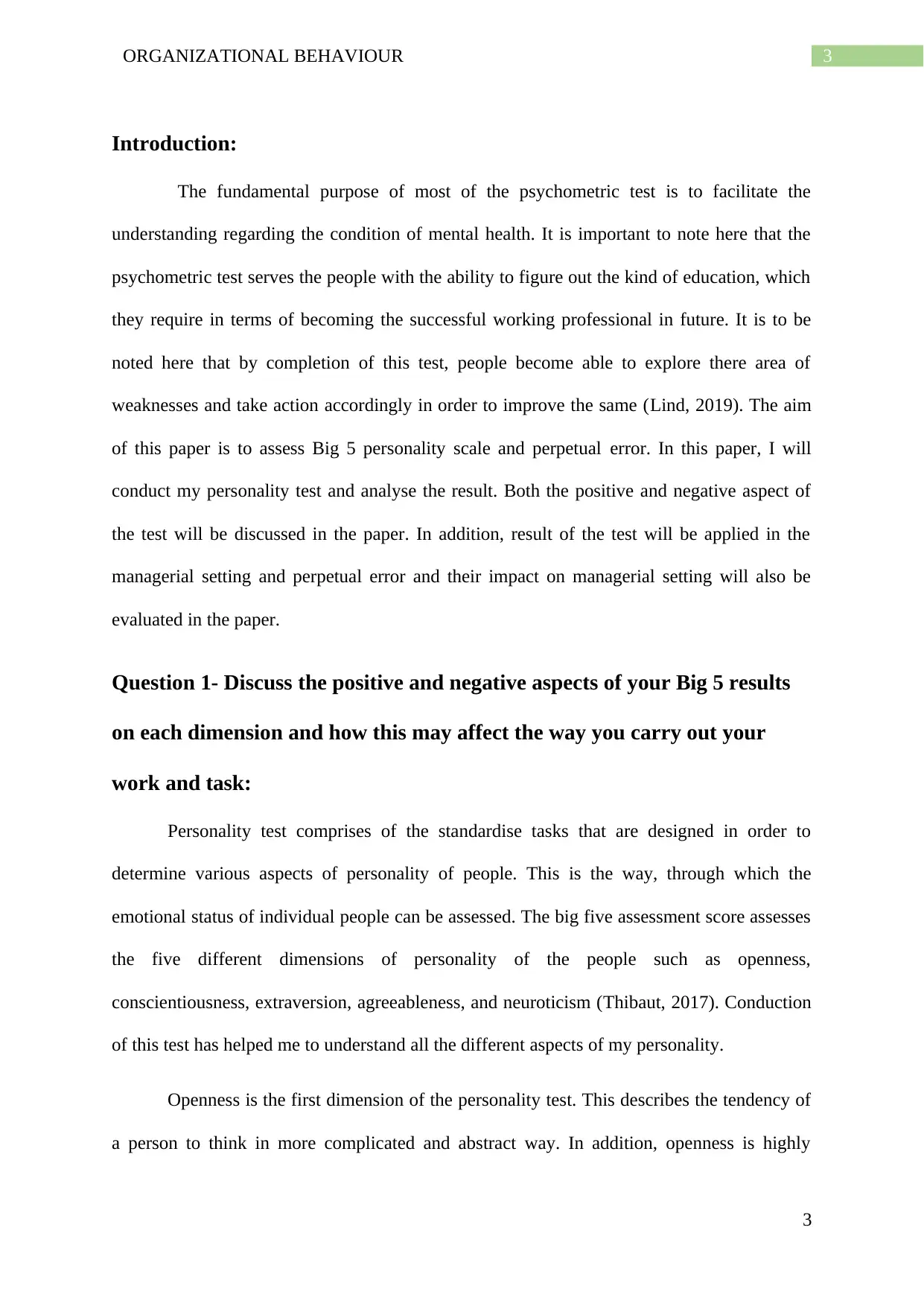
3ORGANIZATIONAL BEHAVIOUR
Introduction:
The fundamental purpose of most of the psychometric test is to facilitate the
understanding regarding the condition of mental health. It is important to note here that the
psychometric test serves the people with the ability to figure out the kind of education, which
they require in terms of becoming the successful working professional in future. It is to be
noted here that by completion of this test, people become able to explore there area of
weaknesses and take action accordingly in order to improve the same (Lind, 2019). The aim
of this paper is to assess Big 5 personality scale and perpetual error. In this paper, I will
conduct my personality test and analyse the result. Both the positive and negative aspect of
the test will be discussed in the paper. In addition, result of the test will be applied in the
managerial setting and perpetual error and their impact on managerial setting will also be
evaluated in the paper.
Question 1- Discuss the positive and negative aspects of your Big 5 results
on each dimension and how this may affect the way you carry out your
work and task:
Personality test comprises of the standardise tasks that are designed in order to
determine various aspects of personality of people. This is the way, through which the
emotional status of individual people can be assessed. The big five assessment score assesses
the five different dimensions of personality of the people such as openness,
conscientiousness, extraversion, agreeableness, and neuroticism (Thibaut, 2017). Conduction
of this test has helped me to understand all the different aspects of my personality.
Openness is the first dimension of the personality test. This describes the tendency of
a person to think in more complicated and abstract way. In addition, openness is highly
3
Introduction:
The fundamental purpose of most of the psychometric test is to facilitate the
understanding regarding the condition of mental health. It is important to note here that the
psychometric test serves the people with the ability to figure out the kind of education, which
they require in terms of becoming the successful working professional in future. It is to be
noted here that by completion of this test, people become able to explore there area of
weaknesses and take action accordingly in order to improve the same (Lind, 2019). The aim
of this paper is to assess Big 5 personality scale and perpetual error. In this paper, I will
conduct my personality test and analyse the result. Both the positive and negative aspect of
the test will be discussed in the paper. In addition, result of the test will be applied in the
managerial setting and perpetual error and their impact on managerial setting will also be
evaluated in the paper.
Question 1- Discuss the positive and negative aspects of your Big 5 results
on each dimension and how this may affect the way you carry out your
work and task:
Personality test comprises of the standardise tasks that are designed in order to
determine various aspects of personality of people. This is the way, through which the
emotional status of individual people can be assessed. The big five assessment score assesses
the five different dimensions of personality of the people such as openness,
conscientiousness, extraversion, agreeableness, and neuroticism (Thibaut, 2017). Conduction
of this test has helped me to understand all the different aspects of my personality.
Openness is the first dimension of the personality test. This describes the tendency of
a person to think in more complicated and abstract way. In addition, openness is highly
3
⊘ This is a preview!⊘
Do you want full access?
Subscribe today to unlock all pages.

Trusted by 1+ million students worldwide
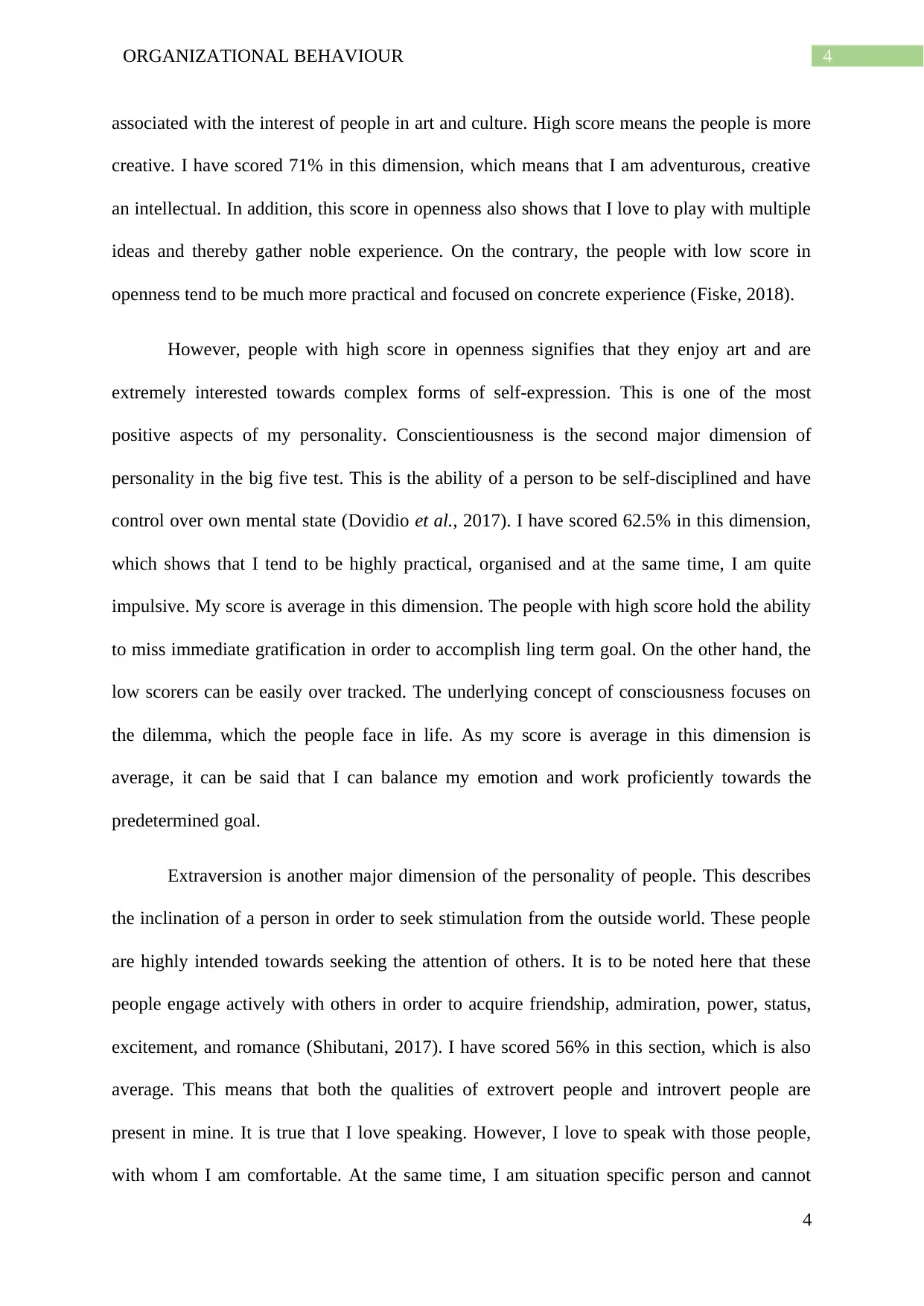
4ORGANIZATIONAL BEHAVIOUR
associated with the interest of people in art and culture. High score means the people is more
creative. I have scored 71% in this dimension, which means that I am adventurous, creative
an intellectual. In addition, this score in openness also shows that I love to play with multiple
ideas and thereby gather noble experience. On the contrary, the people with low score in
openness tend to be much more practical and focused on concrete experience (Fiske, 2018).
However, people with high score in openness signifies that they enjoy art and are
extremely interested towards complex forms of self-expression. This is one of the most
positive aspects of my personality. Conscientiousness is the second major dimension of
personality in the big five test. This is the ability of a person to be self-disciplined and have
control over own mental state (Dovidio et al., 2017). I have scored 62.5% in this dimension,
which shows that I tend to be highly practical, organised and at the same time, I am quite
impulsive. My score is average in this dimension. The people with high score hold the ability
to miss immediate gratification in order to accomplish ling term goal. On the other hand, the
low scorers can be easily over tracked. The underlying concept of consciousness focuses on
the dilemma, which the people face in life. As my score is average in this dimension is
average, it can be said that I can balance my emotion and work proficiently towards the
predetermined goal.
Extraversion is another major dimension of the personality of people. This describes
the inclination of a person in order to seek stimulation from the outside world. These people
are highly intended towards seeking the attention of others. It is to be noted here that these
people engage actively with others in order to acquire friendship, admiration, power, status,
excitement, and romance (Shibutani, 2017). I have scored 56% in this section, which is also
average. This means that both the qualities of extrovert people and introvert people are
present in mine. It is true that I love speaking. However, I love to speak with those people,
with whom I am comfortable. At the same time, I am situation specific person and cannot
4
associated with the interest of people in art and culture. High score means the people is more
creative. I have scored 71% in this dimension, which means that I am adventurous, creative
an intellectual. In addition, this score in openness also shows that I love to play with multiple
ideas and thereby gather noble experience. On the contrary, the people with low score in
openness tend to be much more practical and focused on concrete experience (Fiske, 2018).
However, people with high score in openness signifies that they enjoy art and are
extremely interested towards complex forms of self-expression. This is one of the most
positive aspects of my personality. Conscientiousness is the second major dimension of
personality in the big five test. This is the ability of a person to be self-disciplined and have
control over own mental state (Dovidio et al., 2017). I have scored 62.5% in this dimension,
which shows that I tend to be highly practical, organised and at the same time, I am quite
impulsive. My score is average in this dimension. The people with high score hold the ability
to miss immediate gratification in order to accomplish ling term goal. On the other hand, the
low scorers can be easily over tracked. The underlying concept of consciousness focuses on
the dilemma, which the people face in life. As my score is average in this dimension is
average, it can be said that I can balance my emotion and work proficiently towards the
predetermined goal.
Extraversion is another major dimension of the personality of people. This describes
the inclination of a person in order to seek stimulation from the outside world. These people
are highly intended towards seeking the attention of others. It is to be noted here that these
people engage actively with others in order to acquire friendship, admiration, power, status,
excitement, and romance (Shibutani, 2017). I have scored 56% in this section, which is also
average. This means that both the qualities of extrovert people and introvert people are
present in mine. It is true that I love speaking. However, I love to speak with those people,
with whom I am comfortable. At the same time, I am situation specific person and cannot
4
Paraphrase This Document
Need a fresh take? Get an instant paraphrase of this document with our AI Paraphraser
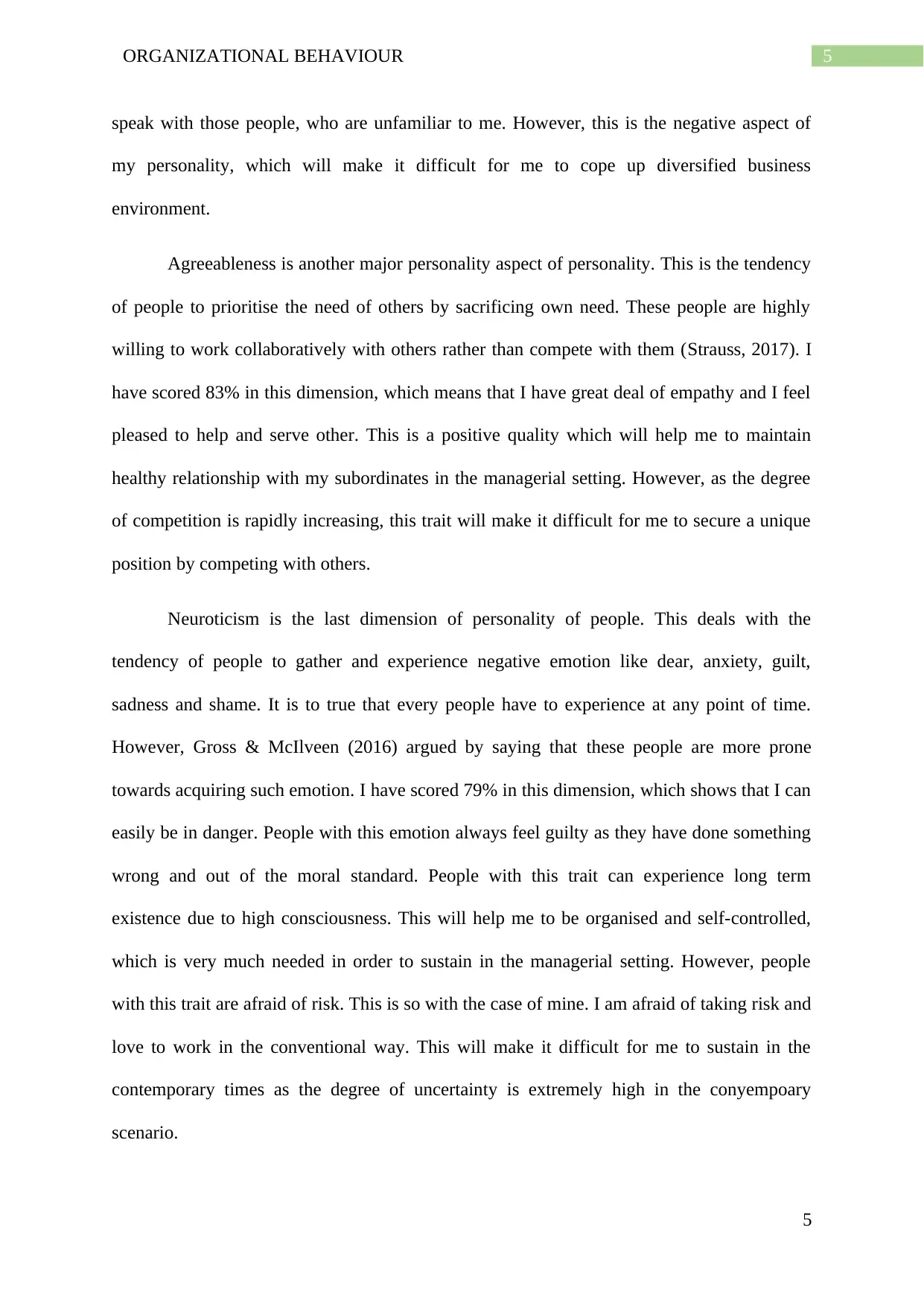
5ORGANIZATIONAL BEHAVIOUR
speak with those people, who are unfamiliar to me. However, this is the negative aspect of
my personality, which will make it difficult for me to cope up diversified business
environment.
Agreeableness is another major personality aspect of personality. This is the tendency
of people to prioritise the need of others by sacrificing own need. These people are highly
willing to work collaboratively with others rather than compete with them (Strauss, 2017). I
have scored 83% in this dimension, which means that I have great deal of empathy and I feel
pleased to help and serve other. This is a positive quality which will help me to maintain
healthy relationship with my subordinates in the managerial setting. However, as the degree
of competition is rapidly increasing, this trait will make it difficult for me to secure a unique
position by competing with others.
Neuroticism is the last dimension of personality of people. This deals with the
tendency of people to gather and experience negative emotion like dear, anxiety, guilt,
sadness and shame. It is to true that every people have to experience at any point of time.
However, Gross & McIlveen (2016) argued by saying that these people are more prone
towards acquiring such emotion. I have scored 79% in this dimension, which shows that I can
easily be in danger. People with this emotion always feel guilty as they have done something
wrong and out of the moral standard. People with this trait can experience long term
existence due to high consciousness. This will help me to be organised and self-controlled,
which is very much needed in order to sustain in the managerial setting. However, people
with this trait are afraid of risk. This is so with the case of mine. I am afraid of taking risk and
love to work in the conventional way. This will make it difficult for me to sustain in the
contemporary times as the degree of uncertainty is extremely high in the conyempoary
scenario.
5
speak with those people, who are unfamiliar to me. However, this is the negative aspect of
my personality, which will make it difficult for me to cope up diversified business
environment.
Agreeableness is another major personality aspect of personality. This is the tendency
of people to prioritise the need of others by sacrificing own need. These people are highly
willing to work collaboratively with others rather than compete with them (Strauss, 2017). I
have scored 83% in this dimension, which means that I have great deal of empathy and I feel
pleased to help and serve other. This is a positive quality which will help me to maintain
healthy relationship with my subordinates in the managerial setting. However, as the degree
of competition is rapidly increasing, this trait will make it difficult for me to secure a unique
position by competing with others.
Neuroticism is the last dimension of personality of people. This deals with the
tendency of people to gather and experience negative emotion like dear, anxiety, guilt,
sadness and shame. It is to true that every people have to experience at any point of time.
However, Gross & McIlveen (2016) argued by saying that these people are more prone
towards acquiring such emotion. I have scored 79% in this dimension, which shows that I can
easily be in danger. People with this emotion always feel guilty as they have done something
wrong and out of the moral standard. People with this trait can experience long term
existence due to high consciousness. This will help me to be organised and self-controlled,
which is very much needed in order to sustain in the managerial setting. However, people
with this trait are afraid of risk. This is so with the case of mine. I am afraid of taking risk and
love to work in the conventional way. This will make it difficult for me to sustain in the
contemporary times as the degree of uncertainty is extremely high in the conyempoary
scenario.
5
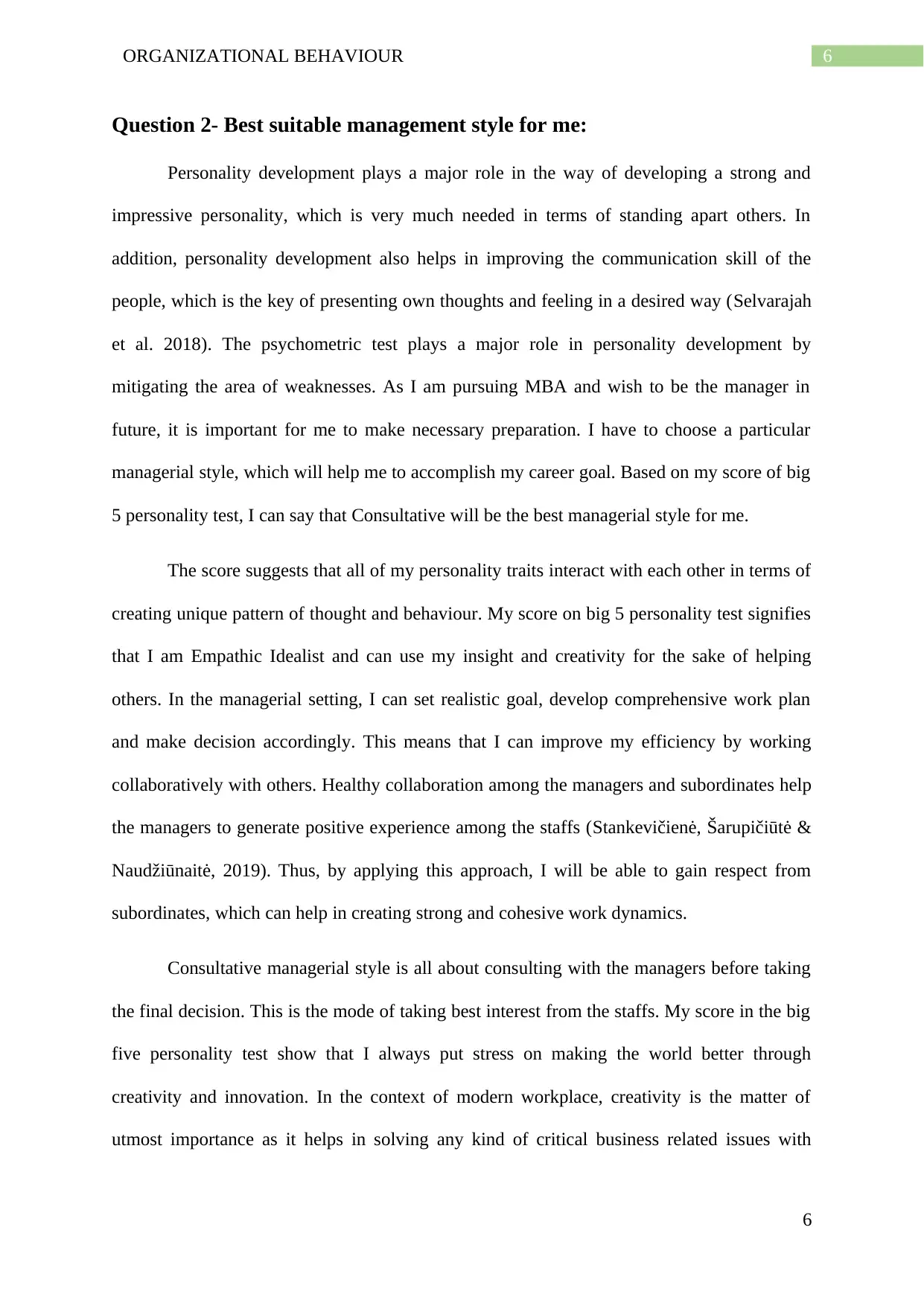
6ORGANIZATIONAL BEHAVIOUR
Question 2- Best suitable management style for me:
Personality development plays a major role in the way of developing a strong and
impressive personality, which is very much needed in terms of standing apart others. In
addition, personality development also helps in improving the communication skill of the
people, which is the key of presenting own thoughts and feeling in a desired way (Selvarajah
et al. 2018). The psychometric test plays a major role in personality development by
mitigating the area of weaknesses. As I am pursuing MBA and wish to be the manager in
future, it is important for me to make necessary preparation. I have to choose a particular
managerial style, which will help me to accomplish my career goal. Based on my score of big
5 personality test, I can say that Consultative will be the best managerial style for me.
The score suggests that all of my personality traits interact with each other in terms of
creating unique pattern of thought and behaviour. My score on big 5 personality test signifies
that I am Empathic Idealist and can use my insight and creativity for the sake of helping
others. In the managerial setting, I can set realistic goal, develop comprehensive work plan
and make decision accordingly. This means that I can improve my efficiency by working
collaboratively with others. Healthy collaboration among the managers and subordinates help
the managers to generate positive experience among the staffs (Stankevičienė, Šarupičiūtė &
Naudžiūnaitė, 2019). Thus, by applying this approach, I will be able to gain respect from
subordinates, which can help in creating strong and cohesive work dynamics.
Consultative managerial style is all about consulting with the managers before taking
the final decision. This is the mode of taking best interest from the staffs. My score in the big
five personality test show that I always put stress on making the world better through
creativity and innovation. In the context of modern workplace, creativity is the matter of
utmost importance as it helps in solving any kind of critical business related issues with
6
Question 2- Best suitable management style for me:
Personality development plays a major role in the way of developing a strong and
impressive personality, which is very much needed in terms of standing apart others. In
addition, personality development also helps in improving the communication skill of the
people, which is the key of presenting own thoughts and feeling in a desired way (Selvarajah
et al. 2018). The psychometric test plays a major role in personality development by
mitigating the area of weaknesses. As I am pursuing MBA and wish to be the manager in
future, it is important for me to make necessary preparation. I have to choose a particular
managerial style, which will help me to accomplish my career goal. Based on my score of big
5 personality test, I can say that Consultative will be the best managerial style for me.
The score suggests that all of my personality traits interact with each other in terms of
creating unique pattern of thought and behaviour. My score on big 5 personality test signifies
that I am Empathic Idealist and can use my insight and creativity for the sake of helping
others. In the managerial setting, I can set realistic goal, develop comprehensive work plan
and make decision accordingly. This means that I can improve my efficiency by working
collaboratively with others. Healthy collaboration among the managers and subordinates help
the managers to generate positive experience among the staffs (Stankevičienė, Šarupičiūtė &
Naudžiūnaitė, 2019). Thus, by applying this approach, I will be able to gain respect from
subordinates, which can help in creating strong and cohesive work dynamics.
Consultative managerial style is all about consulting with the managers before taking
the final decision. This is the mode of taking best interest from the staffs. My score in the big
five personality test show that I always put stress on making the world better through
creativity and innovation. In the context of modern workplace, creativity is the matter of
utmost importance as it helps in solving any kind of critical business related issues with
6
⊘ This is a preview!⊘
Do you want full access?
Subscribe today to unlock all pages.

Trusted by 1+ million students worldwide
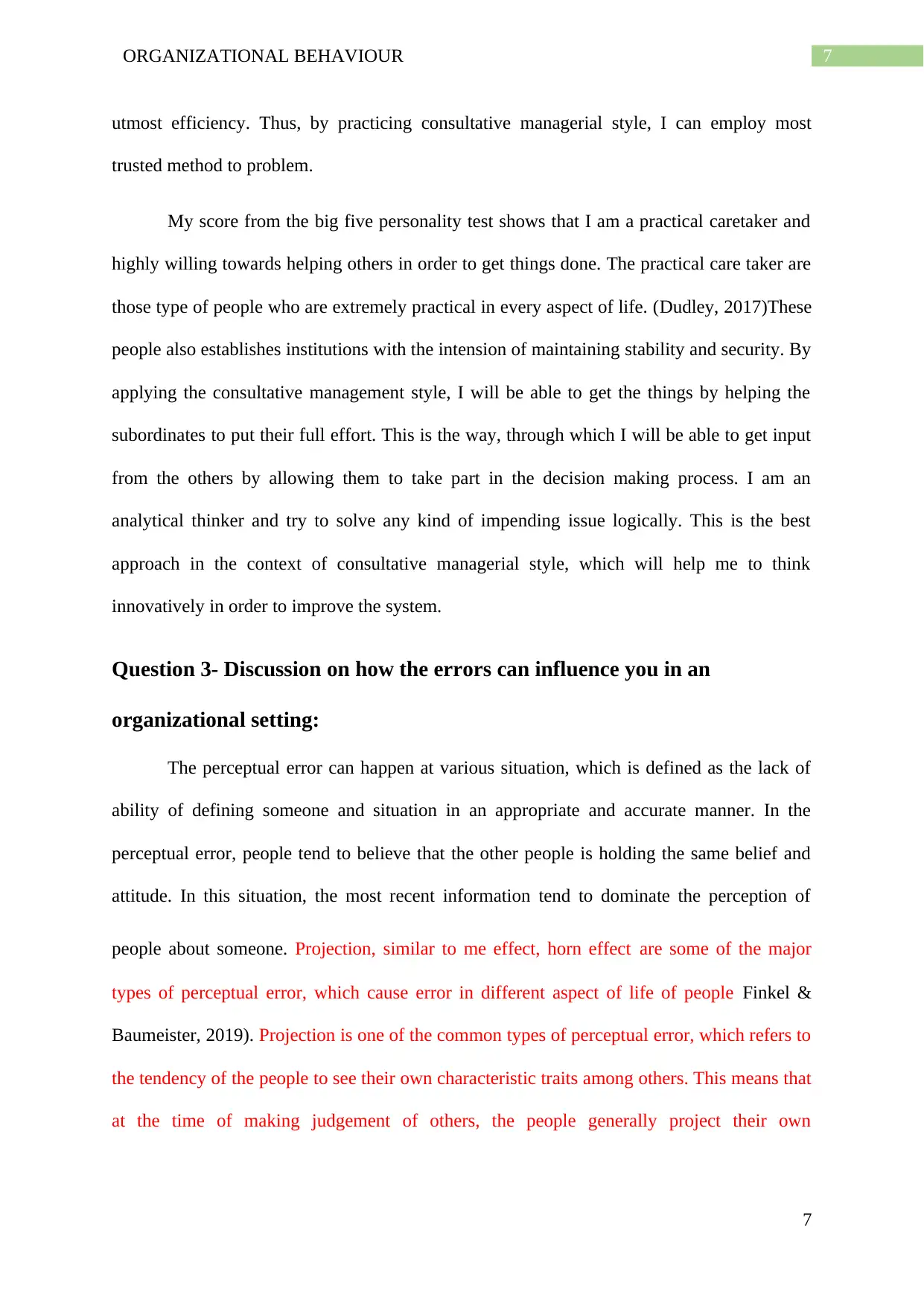
7ORGANIZATIONAL BEHAVIOUR
utmost efficiency. Thus, by practicing consultative managerial style, I can employ most
trusted method to problem.
My score from the big five personality test shows that I am a practical caretaker and
highly willing towards helping others in order to get things done. The practical care taker are
those type of people who are extremely practical in every aspect of life. (Dudley, 2017)These
people also establishes institutions with the intension of maintaining stability and security. By
applying the consultative management style, I will be able to get the things by helping the
subordinates to put their full effort. This is the way, through which I will be able to get input
from the others by allowing them to take part in the decision making process. I am an
analytical thinker and try to solve any kind of impending issue logically. This is the best
approach in the context of consultative managerial style, which will help me to think
innovatively in order to improve the system.
Question 3- Discussion on how the errors can influence you in an
organizational setting:
The perceptual error can happen at various situation, which is defined as the lack of
ability of defining someone and situation in an appropriate and accurate manner. In the
perceptual error, people tend to believe that the other people is holding the same belief and
attitude. In this situation, the most recent information tend to dominate the perception of
people about someone. Projection, similar to me effect, horn effect are some of the major
types of perceptual error, which cause error in different aspect of life of people Finkel &
Baumeister, 2019). Projection is one of the common types of perceptual error, which refers to
the tendency of the people to see their own characteristic traits among others. This means that
at the time of making judgement of others, the people generally project their own
7
utmost efficiency. Thus, by practicing consultative managerial style, I can employ most
trusted method to problem.
My score from the big five personality test shows that I am a practical caretaker and
highly willing towards helping others in order to get things done. The practical care taker are
those type of people who are extremely practical in every aspect of life. (Dudley, 2017)These
people also establishes institutions with the intension of maintaining stability and security. By
applying the consultative management style, I will be able to get the things by helping the
subordinates to put their full effort. This is the way, through which I will be able to get input
from the others by allowing them to take part in the decision making process. I am an
analytical thinker and try to solve any kind of impending issue logically. This is the best
approach in the context of consultative managerial style, which will help me to think
innovatively in order to improve the system.
Question 3- Discussion on how the errors can influence you in an
organizational setting:
The perceptual error can happen at various situation, which is defined as the lack of
ability of defining someone and situation in an appropriate and accurate manner. In the
perceptual error, people tend to believe that the other people is holding the same belief and
attitude. In this situation, the most recent information tend to dominate the perception of
people about someone. Projection, similar to me effect, horn effect are some of the major
types of perceptual error, which cause error in different aspect of life of people Finkel &
Baumeister, 2019). Projection is one of the common types of perceptual error, which refers to
the tendency of the people to see their own characteristic traits among others. This means that
at the time of making judgement of others, the people generally project their own
7
Paraphrase This Document
Need a fresh take? Get an instant paraphrase of this document with our AI Paraphraser
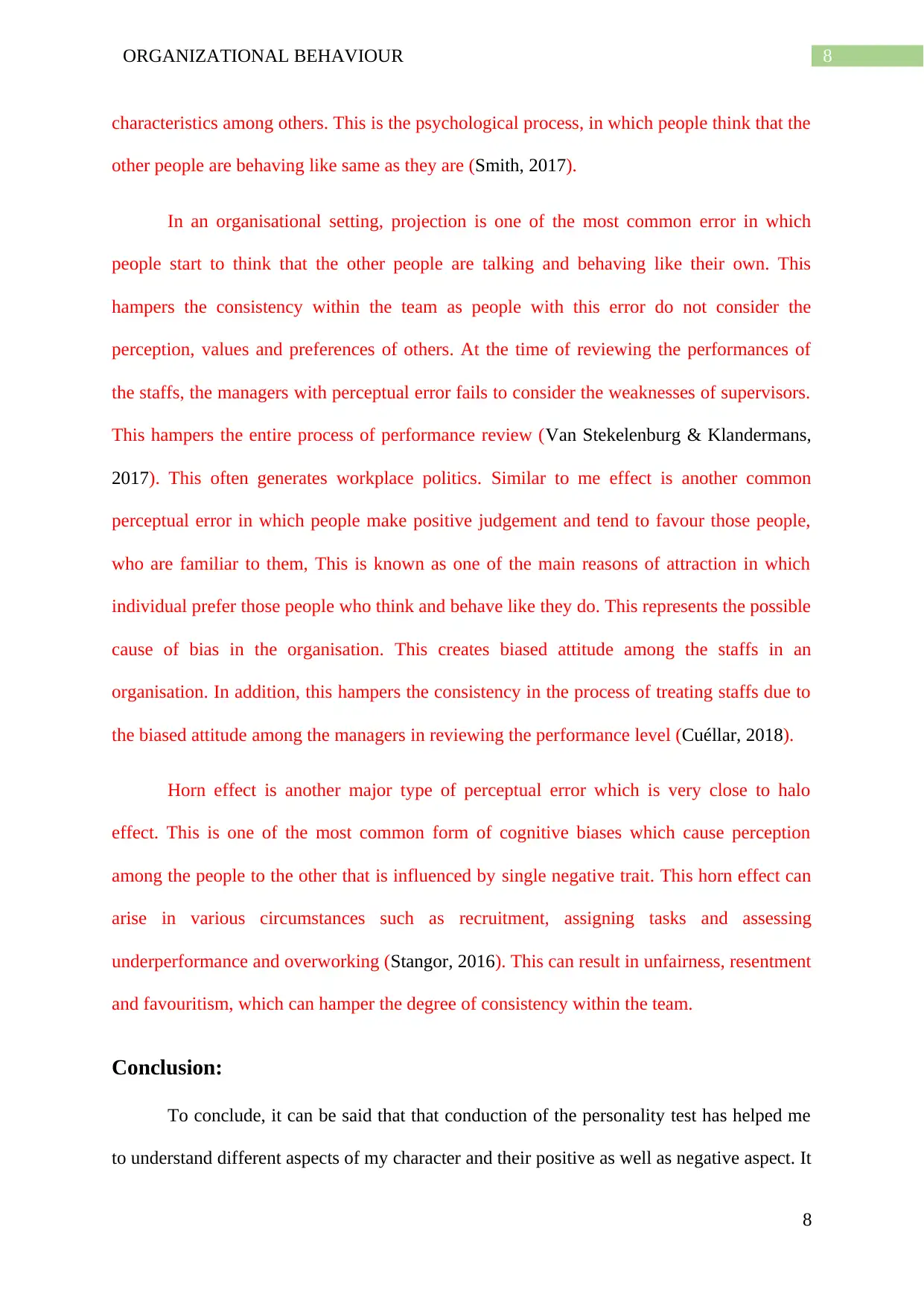
8ORGANIZATIONAL BEHAVIOUR
characteristics among others. This is the psychological process, in which people think that the
other people are behaving like same as they are (Smith, 2017).
In an organisational setting, projection is one of the most common error in which
people start to think that the other people are talking and behaving like their own. This
hampers the consistency within the team as people with this error do not consider the
perception, values and preferences of others. At the time of reviewing the performances of
the staffs, the managers with perceptual error fails to consider the weaknesses of supervisors.
This hampers the entire process of performance review (Van Stekelenburg & Klandermans,
2017). This often generates workplace politics. Similar to me effect is another common
perceptual error in which people make positive judgement and tend to favour those people,
who are familiar to them, This is known as one of the main reasons of attraction in which
individual prefer those people who think and behave like they do. This represents the possible
cause of bias in the organisation. This creates biased attitude among the staffs in an
organisation. In addition, this hampers the consistency in the process of treating staffs due to
the biased attitude among the managers in reviewing the performance level (Cuéllar, 2018).
Horn effect is another major type of perceptual error which is very close to halo
effect. This is one of the most common form of cognitive biases which cause perception
among the people to the other that is influenced by single negative trait. This horn effect can
arise in various circumstances such as recruitment, assigning tasks and assessing
underperformance and overworking (Stangor, 2016). This can result in unfairness, resentment
and favouritism, which can hamper the degree of consistency within the team.
Conclusion:
To conclude, it can be said that that conduction of the personality test has helped me
to understand different aspects of my character and their positive as well as negative aspect. It
8
characteristics among others. This is the psychological process, in which people think that the
other people are behaving like same as they are (Smith, 2017).
In an organisational setting, projection is one of the most common error in which
people start to think that the other people are talking and behaving like their own. This
hampers the consistency within the team as people with this error do not consider the
perception, values and preferences of others. At the time of reviewing the performances of
the staffs, the managers with perceptual error fails to consider the weaknesses of supervisors.
This hampers the entire process of performance review (Van Stekelenburg & Klandermans,
2017). This often generates workplace politics. Similar to me effect is another common
perceptual error in which people make positive judgement and tend to favour those people,
who are familiar to them, This is known as one of the main reasons of attraction in which
individual prefer those people who think and behave like they do. This represents the possible
cause of bias in the organisation. This creates biased attitude among the staffs in an
organisation. In addition, this hampers the consistency in the process of treating staffs due to
the biased attitude among the managers in reviewing the performance level (Cuéllar, 2018).
Horn effect is another major type of perceptual error which is very close to halo
effect. This is one of the most common form of cognitive biases which cause perception
among the people to the other that is influenced by single negative trait. This horn effect can
arise in various circumstances such as recruitment, assigning tasks and assessing
underperformance and overworking (Stangor, 2016). This can result in unfairness, resentment
and favouritism, which can hamper the degree of consistency within the team.
Conclusion:
To conclude, it can be said that that conduction of the personality test has helped me
to understand different aspects of my character and their positive as well as negative aspect. It
8
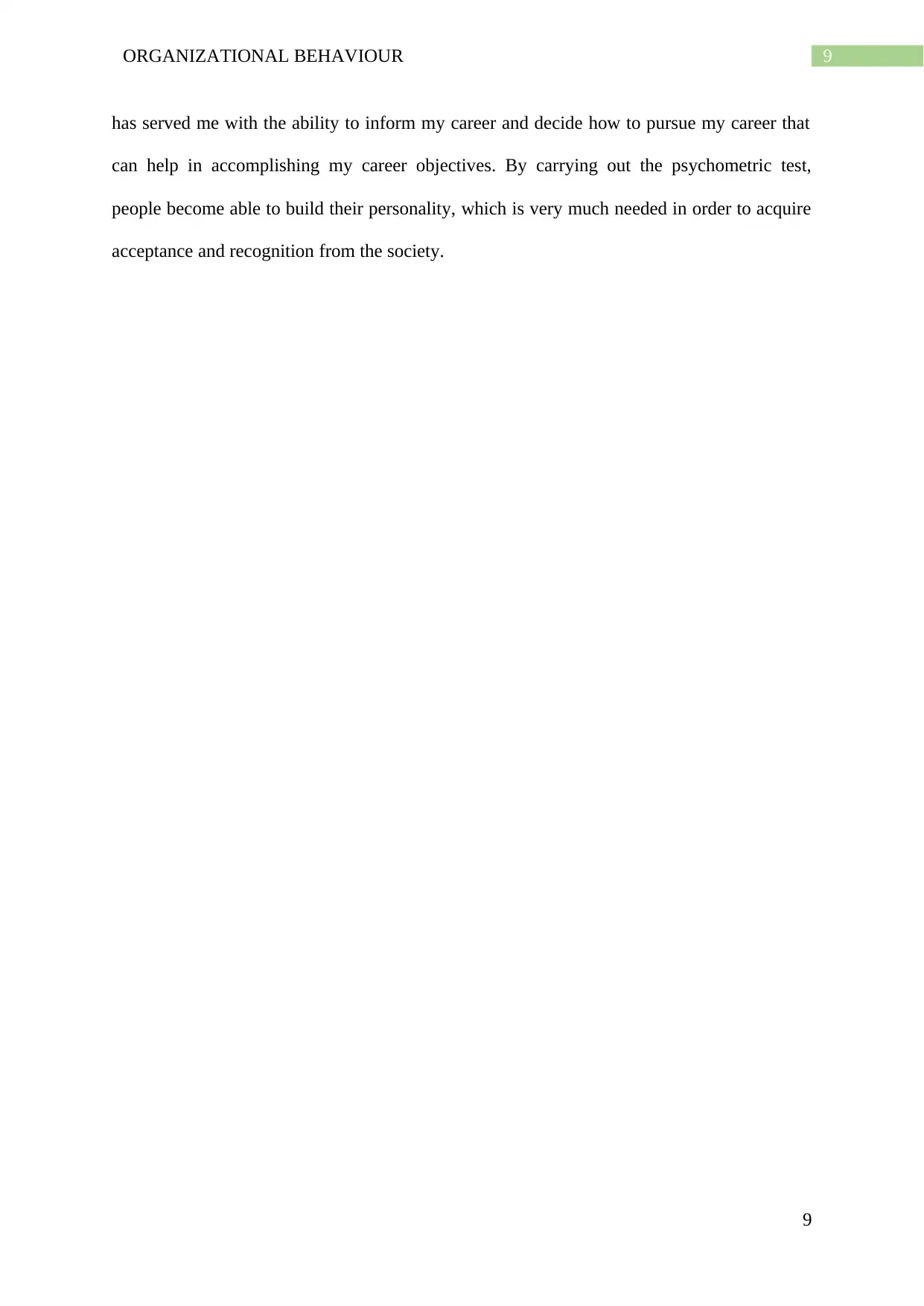
9ORGANIZATIONAL BEHAVIOUR
has served me with the ability to inform my career and decide how to pursue my career that
can help in accomplishing my career objectives. By carrying out the psychometric test,
people become able to build their personality, which is very much needed in order to acquire
acceptance and recognition from the society.
9
has served me with the ability to inform my career and decide how to pursue my career that
can help in accomplishing my career objectives. By carrying out the psychometric test,
people become able to build their personality, which is very much needed in order to acquire
acceptance and recognition from the society.
9
⊘ This is a preview!⊘
Do you want full access?
Subscribe today to unlock all pages.

Trusted by 1+ million students worldwide
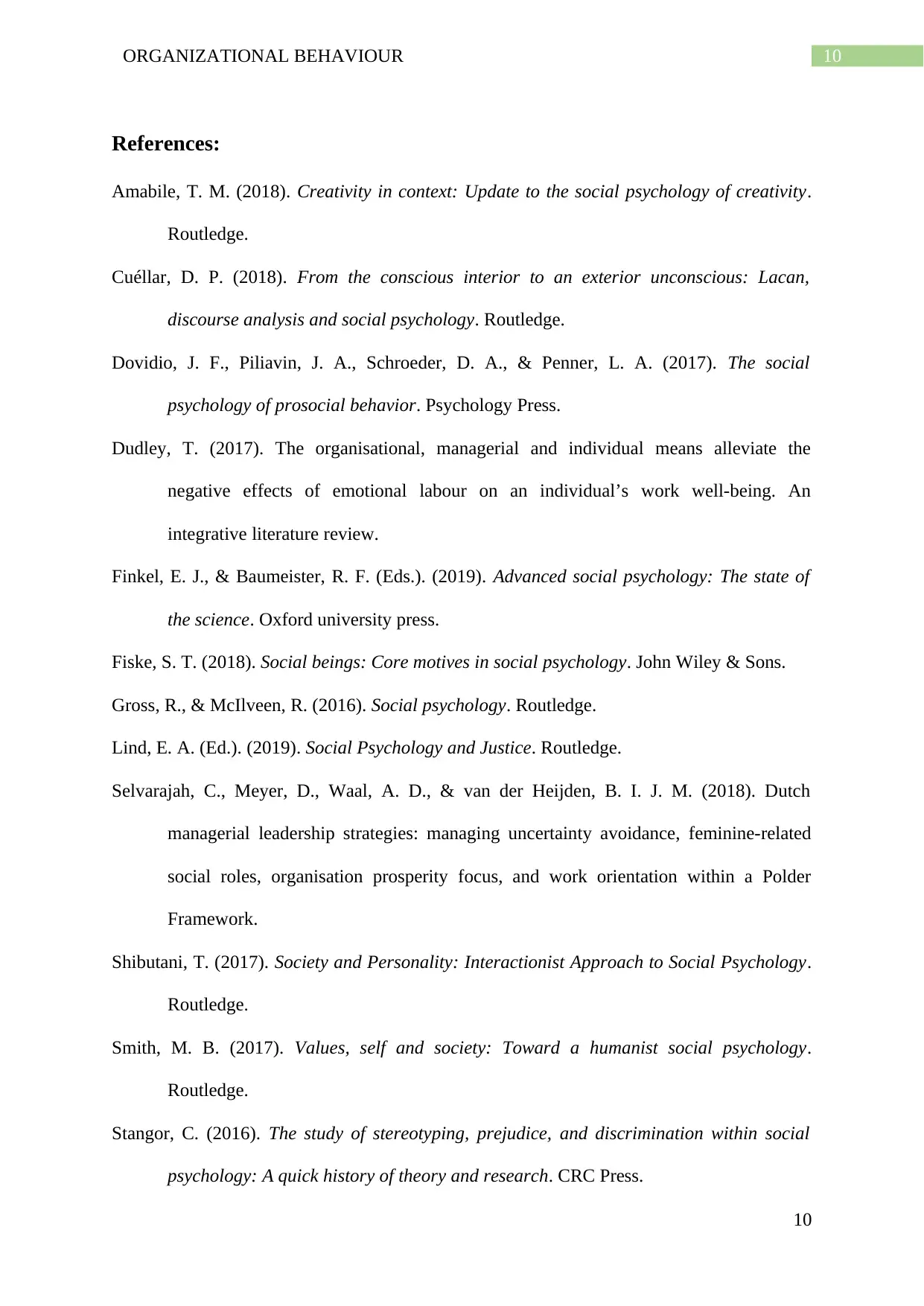
10ORGANIZATIONAL BEHAVIOUR
References:
Amabile, T. M. (2018). Creativity in context: Update to the social psychology of creativity.
Routledge.
Cuéllar, D. P. (2018). From the conscious interior to an exterior unconscious: Lacan,
discourse analysis and social psychology. Routledge.
Dovidio, J. F., Piliavin, J. A., Schroeder, D. A., & Penner, L. A. (2017). The social
psychology of prosocial behavior. Psychology Press.
Dudley, T. (2017). The organisational, managerial and individual means alleviate the
negative effects of emotional labour on an individual’s work well-being. An
integrative literature review.
Finkel, E. J., & Baumeister, R. F. (Eds.). (2019). Advanced social psychology: The state of
the science. Oxford university press.
Fiske, S. T. (2018). Social beings: Core motives in social psychology. John Wiley & Sons.
Gross, R., & McIlveen, R. (2016). Social psychology. Routledge.
Lind, E. A. (Ed.). (2019). Social Psychology and Justice. Routledge.
Selvarajah, C., Meyer, D., Waal, A. D., & van der Heijden, B. I. J. M. (2018). Dutch
managerial leadership strategies: managing uncertainty avoidance, feminine-related
social roles, organisation prosperity focus, and work orientation within a Polder
Framework.
Shibutani, T. (2017). Society and Personality: Interactionist Approach to Social Psychology.
Routledge.
Smith, M. B. (2017). Values, self and society: Toward a humanist social psychology.
Routledge.
Stangor, C. (2016). The study of stereotyping, prejudice, and discrimination within social
psychology: A quick history of theory and research. CRC Press.
10
References:
Amabile, T. M. (2018). Creativity in context: Update to the social psychology of creativity.
Routledge.
Cuéllar, D. P. (2018). From the conscious interior to an exterior unconscious: Lacan,
discourse analysis and social psychology. Routledge.
Dovidio, J. F., Piliavin, J. A., Schroeder, D. A., & Penner, L. A. (2017). The social
psychology of prosocial behavior. Psychology Press.
Dudley, T. (2017). The organisational, managerial and individual means alleviate the
negative effects of emotional labour on an individual’s work well-being. An
integrative literature review.
Finkel, E. J., & Baumeister, R. F. (Eds.). (2019). Advanced social psychology: The state of
the science. Oxford university press.
Fiske, S. T. (2018). Social beings: Core motives in social psychology. John Wiley & Sons.
Gross, R., & McIlveen, R. (2016). Social psychology. Routledge.
Lind, E. A. (Ed.). (2019). Social Psychology and Justice. Routledge.
Selvarajah, C., Meyer, D., Waal, A. D., & van der Heijden, B. I. J. M. (2018). Dutch
managerial leadership strategies: managing uncertainty avoidance, feminine-related
social roles, organisation prosperity focus, and work orientation within a Polder
Framework.
Shibutani, T. (2017). Society and Personality: Interactionist Approach to Social Psychology.
Routledge.
Smith, M. B. (2017). Values, self and society: Toward a humanist social psychology.
Routledge.
Stangor, C. (2016). The study of stereotyping, prejudice, and discrimination within social
psychology: A quick history of theory and research. CRC Press.
10
Paraphrase This Document
Need a fresh take? Get an instant paraphrase of this document with our AI Paraphraser
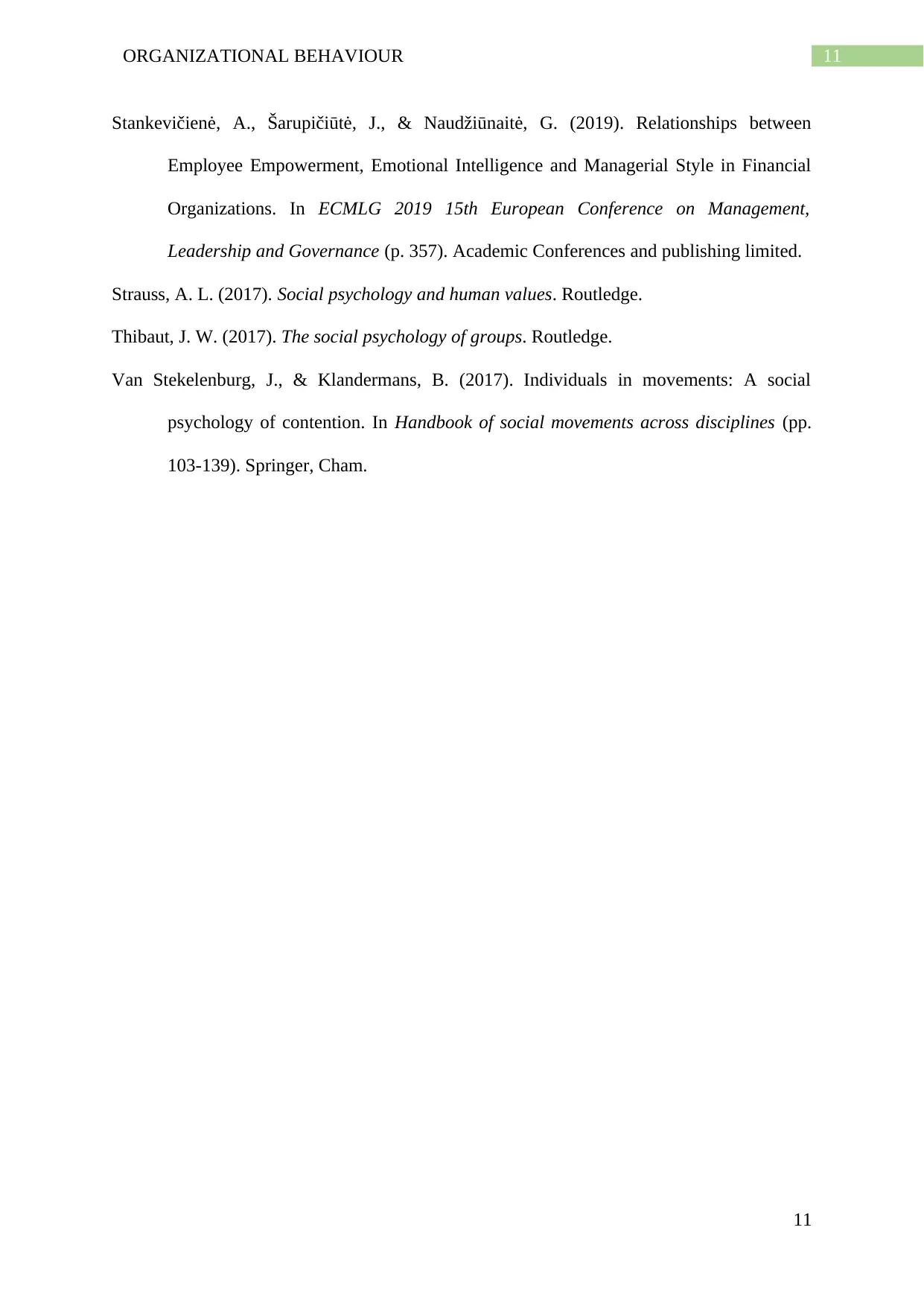
11ORGANIZATIONAL BEHAVIOUR
Stankevičienė, A., Šarupičiūtė, J., & Naudžiūnaitė, G. (2019). Relationships between
Employee Empowerment, Emotional Intelligence and Managerial Style in Financial
Organizations. In ECMLG 2019 15th European Conference on Management,
Leadership and Governance (p. 357). Academic Conferences and publishing limited.
Strauss, A. L. (2017). Social psychology and human values. Routledge.
Thibaut, J. W. (2017). The social psychology of groups. Routledge.
Van Stekelenburg, J., & Klandermans, B. (2017). Individuals in movements: A social
psychology of contention. In Handbook of social movements across disciplines (pp.
103-139). Springer, Cham.
11
Stankevičienė, A., Šarupičiūtė, J., & Naudžiūnaitė, G. (2019). Relationships between
Employee Empowerment, Emotional Intelligence and Managerial Style in Financial
Organizations. In ECMLG 2019 15th European Conference on Management,
Leadership and Governance (p. 357). Academic Conferences and publishing limited.
Strauss, A. L. (2017). Social psychology and human values. Routledge.
Thibaut, J. W. (2017). The social psychology of groups. Routledge.
Van Stekelenburg, J., & Klandermans, B. (2017). Individuals in movements: A social
psychology of contention. In Handbook of social movements across disciplines (pp.
103-139). Springer, Cham.
11
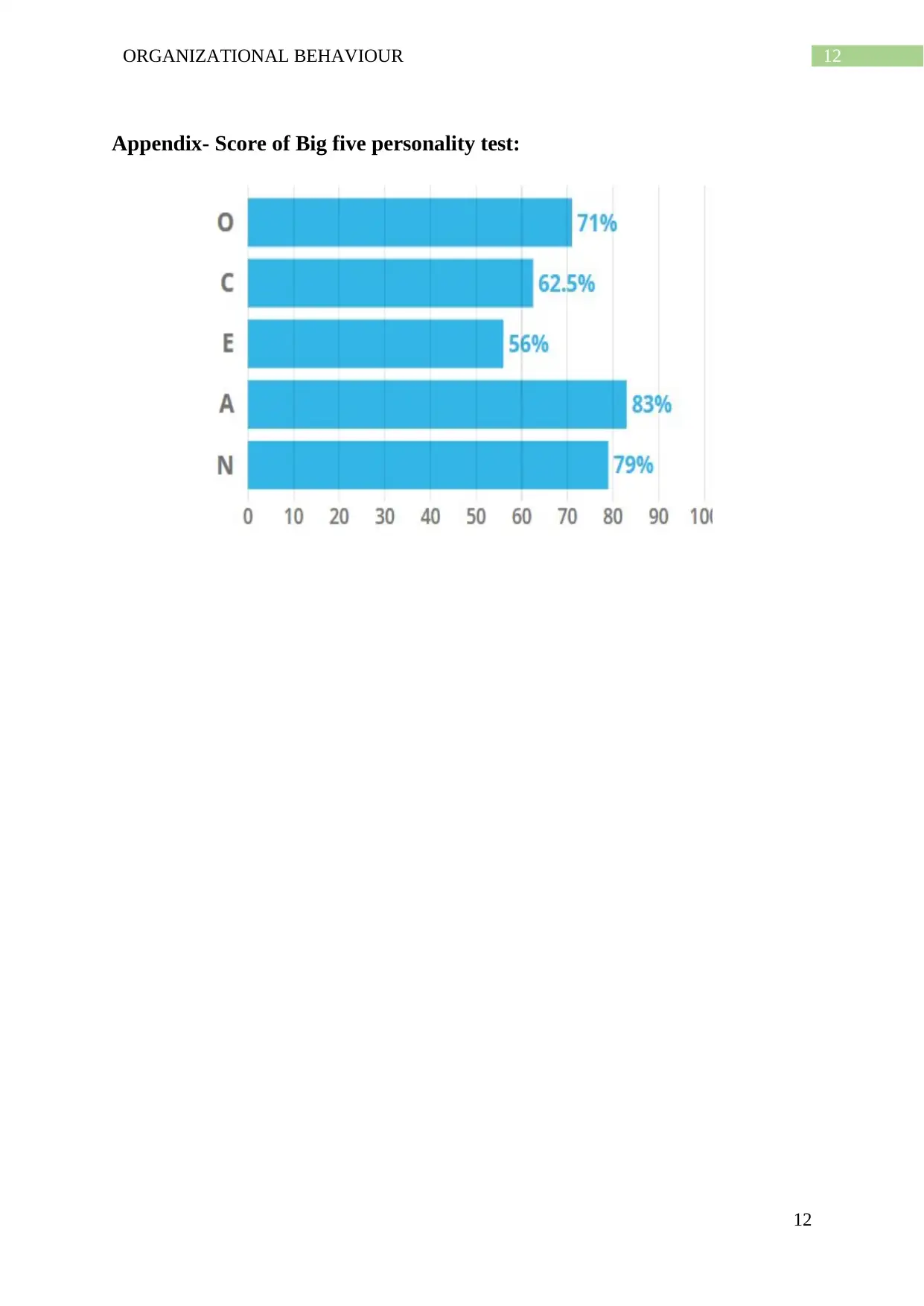
12ORGANIZATIONAL BEHAVIOUR
Appendix- Score of Big five personality test:
12
Appendix- Score of Big five personality test:
12
⊘ This is a preview!⊘
Do you want full access?
Subscribe today to unlock all pages.

Trusted by 1+ million students worldwide
1 out of 12
Related Documents
Your All-in-One AI-Powered Toolkit for Academic Success.
+13062052269
info@desklib.com
Available 24*7 on WhatsApp / Email
![[object Object]](/_next/static/media/star-bottom.7253800d.svg)
Unlock your academic potential
Copyright © 2020–2025 A2Z Services. All Rights Reserved. Developed and managed by ZUCOL.





